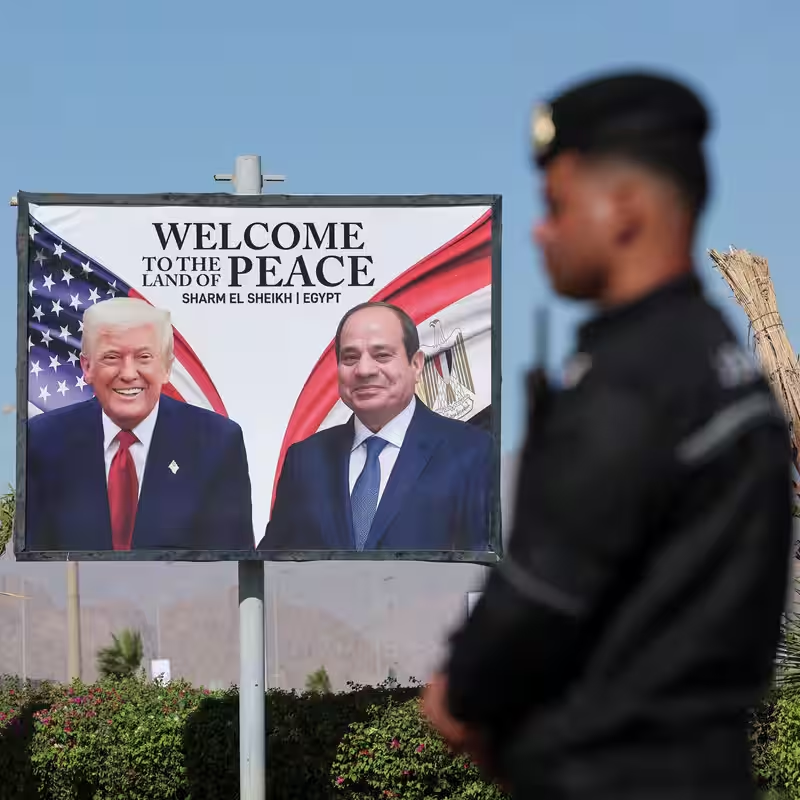Table of Contents
- Two Hours That Could Change the Middle East
- The Staggering Human Cost of the Gaza War
- Trump’s 20-Point Plan: Promise or Pitfall?
- Egypt’s Delicate Balancing Act
- Gulf States Insist: No Reconstruction Without Palestinian Authority
- Key Obstacles to a Lasting Gaza Ceasefire
- Sources
Egypt Summit Sparks Hope for Gaza Ceasefire
On Monday, October 13, 2025, more than 20 world leaders gathered in Sharm el-Sheikh, Egypt, for a high-stakes summit aimed at ending the devastating Gaza war. The two-hour meeting—marked by banners of President Donald Trump and Egyptian President Abdel Fattah el-Sisi—was hailed by Egypt’s presidency as delivering an “agreement to end the war in Gaza.”
But beyond the photo ops and diplomatic handshakes, experts warn that the real challenge begins now: turning broad commitments into concrete, sustainable peace.
The Staggering Human Cost of the Gaza War
The conflict began on October 7, 2023, when Hamas-led militants launched a surprise attack on southern Israel, killing approximately 1,200 people and taking 250 hostages. Israel’s military response has since resulted in over 67,000 Palestinian deaths, according to current estimates.
Repeated ceasefire attempts have failed, leaving civilians trapped in rubble and humanitarian aid severely restricted. The urgency for a Gaza ceasefire has never been greater.
Trump’s 20-Point Plan: Promise or Pitfall?
President Trump’s September 2025 peace proposal has injected new momentum into stalled talks. The plan includes reopening Gaza’s Rafah border crossing with Egypt, facilitating humanitarian aid, and creating safe corridors for civilians.
“The world finally got something they have long wanted: U.S. buy-in,” said Aziz Alghashian, a lecturer at Naif Arab University for Security Sciences in Riyadh. “But how to keep the American weight there while they work out the details is the harder part.”
Analysts note a troubling gap: the plan lacks a clear roadmap for political transition or post-conflict governance in Gaza—a void that could reignite violence.
Egypt’s Delicate Balancing Act
Egypt is central to the ceasefire framework. As the only Arab neighbor sharing a land border with Gaza, Cairo is expected to manage refugee flows and security coordination.
Yet Egyptian officials are deeply cautious. They fear being seen as complicit in Palestinian displacement—and worry that Hamas fighters could infiltrate refugee groups, potentially triggering Israeli military action on Egyptian soil.
“The challenges are not really in the first stage,” said Aymen Abdel Wahab of the Al Ahram Center in Cairo. “Egypt will see more challenges in the second stage, as it works on the security sector and maintaining the peace.”
Gulf States Insist: No Reconstruction Without Palestinian Authority
Saudi Arabia, the UAE, and other Gulf nations are expected to fund Gaza’s reconstruction—but with strict conditions. Chief among them: the inclusion of the Palestinian Authority (PA) in any governance or rebuilding effort.
Prime Minister Benjamin Netanyahu’s recent statement that “the military campaign in Gaza is not over” has only deepened Gulf skepticism. Without PA involvement, leaders fear their billions could prop up an unstable vacuum—or worse, a de facto Israeli occupation.
“This is really necessary to elicit support from Arab and Muslim states,” Alghashian emphasized. “Otherwise it looks like they are funding a new form of occupation—and that is exactly what they don’t want.”
Key Obstacles to a Lasting Gaza Ceasefire
Three major issues remain unresolved:
- Hamas disarmament: Israel demands full demilitarization; Hamas shows no sign of compliance.
- Israeli withdrawal: Will Israel fully exit Gaza, or maintain “security zones”?
- Political legitimacy: Who governs post-war Gaza—the PA, local councils, or an international body?
With Trump departing the region on October 14, the burden now falls on regional actors to turn summit symbolism into lasting peace.
Sources
The New York Times: Arab Leaders Brace for Tough Negotiations at Egypt Summit




